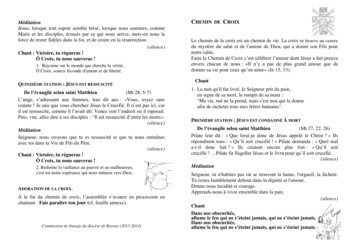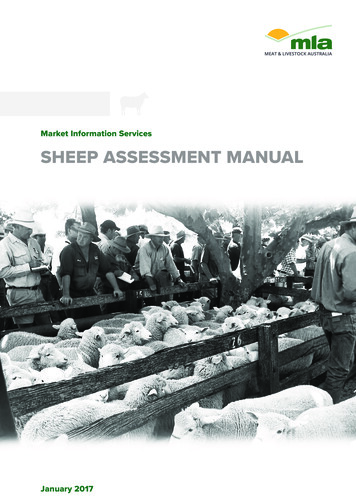
Transcription
St. Croix Hair SheepSt. Croix Hair Sheep Breeders, Inc.Handbook
Table of ContentsHistory of St. Croix SheepBreed CharacteristicsBreed StandardGeneral Sheep ManagementSt. Croix UsesRegistration234578 Linda O’NeillHistory of the St. Croix SheepHair sheep from West Africa were introduced into the Caribbean in the 1500s.From this introduction, different breeds of sheep developed accounting for less than 2million head throughout the Caribbean region. It is believed that they descended fromthe hair sheep of West Africa, but some feel it is a cross between the Wiltshire Hornand the native Criollo. The Virgin Island breed was introduced into the United States inthe 1960s by Michael Piel of Maine. A second importation in 1975 was taken to UtahState University by Dr. Warren Foote. It is from these sheep that the St. Croix breed hasbeen established in the United States. Small flocks were established in Florida, NorthCarolina, Ohio and California in addition to Utah for experimental purposes. Utah StateUniversity personnel found St. Croix to have attributes so interesting and useful theyfounded the registry and created the breed. It remains a closed breed, however therehave been recent imports of some animals and semen from the Island of St. Croix.Hair sheep comprise approximately ten percent of the world sheep population and arelocated primarily in the tropical regions of Africa, South America and the Caribbean.Caribbean hair sheep, such as the St. Croix, are prolific and breed throughout the yearand thus are of interest to the U.S. sheep industry. Currently, the St. Croix is still a rarebreed in the United States with approximately 5000 registered sheep in 1999 but isgaining in popularity.
St. Croix CharacteristicsGeneral InformationThe St. Croix is an attractive all white sheep of moderate size and has a haircoat of consistent texture. They are gentle and easy to handle and both sexesare hornless. They are a true hair sheep and shed their winter coat of hair andfine downy fiber each spring and never need shearing. They have a slenderhair covered tail that does not need to be docked. Mature rams sport a lion-likemane which may fall to the knees.AdaptabilitySt. Croix Hair Sheep easily adapt to various climates. In cold weather theygrow a thick winter coat which is then shed during warm weather. Their coatis hollow medullar hair which allows the sheep to shed water and thus theyare able to tolerate heat and humidity as well as cold weather. They havesuperior inherent resistance to internal parasites, general good health and fewhoof problems. Considered by many as ‘Parasitic Pasture Vacuums’ they helpto eliminate parasites from pastures thereby reducing the need for frequentworming. (Zadjac – Virginia Tech, April 1999)SizeThe adult females weigh up to 150 pounds and the rams weigh up to 200pounds. Lambs at birth weigh an average of 6-7 pounds.ReproductionEwes and rams have early puberty and a long reproductive life. Ewes can havethree lamb crops in two years with few birthing problems. St. Croix have a highmultiple birth rate in the range of 50-75%. The lambing rate is 195-200%.Carcass and GrowthLambs finish without excessive fat and the carcass conformation is similarto that of a Ramboulliet with the exception that the St. Croix has a higherslaughter yield due to smaller bone and fat. Meat yield is 23% more percarcass. The meat is naturally low in cholesterol with a mild flavor and aroma.The tanned hides have a near deer skin quality.TemperamentSt. Croix sheep are very tractable and easy to handle. They are active andvigorous, but show no tendency to be wild or flighty. The rams exhibit littletendency to butt or charge. The ewes are superb mothers. St. Croix are verycomfortable around people and are easily managed in handling systems. Theyflock closely and are increasingly used to train herding dogs.
St. Croix StandardGeneral AppearanceThe St. Croix is a hair sheep. It is of moderate frame size with a long muscletype/pattern and a well-sprung barrel. The coat is white and is shed each year.HeadBoth sexes are naturally polled with no visible scurs. They have an attractiveprofile with the males exhibiting a “Roman” nose. Ears should be fine texturedneither upturned nor drooping, giving the appearance of alertness. The eyesare large and clear. The head should be carried in an upright manner on a longgraceful neck.Top LineThe neck should join smoothly to the shoulder. There may be a dip in thetopline immediately after the wither; the back then continuing in a lengthymanner to the point of the hip at which the croup drops at a relatively acuteangle to the tail head. This angle is believed to facilitate the ease of lambingcommon in this breed.BodyThe body should be symmetrical, deep and long when profiled from the side.St. Croix sheep are of moderate size and build when viewed from the front orback. The hips should be broad.LegsThe forelegs should be straight with feet placed squarely underneath. The hindlegs should not evidence “cow hocking” and the pasterns should be strong andupright.MusclingSt. Croix have a moderate volume of muscle. Muscling should appear long andwell tied-in at the joints. Heavier muscling should be encouraged but not at theexpense of overall breed type.Udder/ScrotumEwes should have well formed even udders with two good teats. Rams shouldhave two large, even, well developed testicles.CoatThe St. Croix is a white hair sheep. They should show evidence of a trueshedding coat. However, a softer wool undercoat on younger animalsshould not be penalized. Rams should have a mane of long coarse hairextending from the back of the neck even reaching the knee at maturity.There may be a dark pigment around the eyes, nostrils and lips. Not morethan ¼ of the ear at the tip should carry dark pigments.
St. Croix StandardDisqualifications:Body spot larger than a U.S. quarter dollarMonorchid or cryptochidHorns or large visible scursEvidence of shearing or body clippingGeneral Sheep ManagementGestationThe average gestation duration is 150 days.PubertyBoth sexes of the St. Croix are precocious sexually. The males reach pubertyas early as four months and the females breed to lamb at one year of age.Reproductive RateLambing rate varies from 150-200% with two lambings a year not uncommon.Reproductive LifespanEwes will remain productive for 8 to 10 years.Breeding SeasonThe ewes have the ability to breed throughout most of the year in latitudesaway from the equator and the ability to rebreed within a few weeks afterlambing. A significant proportion of the St. Croix can produce two lamb crops inone year.St. Croix are increasingly being used to cross breed to wool breeds. A studyout of Dixon Springs Agricultural Center by the University of Illinois from 1985to 1991 concluded that cross bred ewes bred to hair breed rams (St. Croix andBarbados Blackbelly were used) were superior for fertility, lamb survival, lambweaning weight and ewe productivity.Birth WeightsThe average birth weights range from 6 to 7 pounds for twin births. Single birthlambs weigh slightly more.LambingLambing is generally easy with few complications.
ShearingSt. Croix are haired sheep and naturally shed their winter coats in the spring.For the small flock owner this trait is usually a net saving due to the shearingcost being more than the wool income.DockingUnlike wool sheep, tail docking is not required. If the tail is docked, theAmerican Veterinary Medicine Association recommends that the “tail bedocked at the level of the distal end of the caudal tail fold.”FencingSt. Croix respond well to electric fencing when it is used for managed intensivegrazing. Two hot strands or electric netting is sufficient for interior fencing. Thesheep also respond well to guardian dogs that live with them year round. Otherpredator control animals that work well include donkeys and Llama.FeedingSt. Croix utilize coarse fodder more efficiently than other sheep. They areactive grazers. Grass feeding is preferable to feed lot management as thelatter only adds fat.Parasite ManagementIn grazing studies conducted by scientists at the Agricultural Research Serviceat the USDA on contaminated pastures, St. Croix lambs have developedan almost complete resistance to certain parasites within In another studyconducted by Gamble and Zajac for ARS and Virginia Tech, the scientistsfound that St. Croix “demonstrated high levels of acquired resistance toHaemonchus contortus under conditions of experimental or natural infection.”The APHIS (Animal and Plant Health Inspection Service) of the USDA reportedin 1999 that there had been no documented cases of Scrapie in St. Croixsheep. When grazing out on fresh, natural pasture they are more parasiteresistant than wool sheep. Frequent, routine worming remains unnecessarywith the St. Croix. Worming management varies from region to region aroundthe country. New lambs should be wormed at approximately 2 months whichshould carry them until their own resistance builds at approximately 4-5 monthsof age. Worming should be conducted after fecal studies indicate the presenceof worms. Because of the physical characteristics of St. Croix sheep it is easyto check the physical condition of the sheep to determine whether they haveworms.Cross BreedingCross breeding with St. Croix will produce higher parasite tolerance andresistance in other sheep.Cross breeding of St. Croix with wool sheep will produce a hair sheep within 3generations.
St. Croix UsesMeat ConsumptionMembers of the ethnic market have found the St. Croix provide a clean, fatfree carcass of mild firm meat available at all ages and at all times of the yeardue to their non-seasonal breeding habits. The moderate size of the St. Croixis ideal for use by any lamb/mutton lover and permits on-site slaughter for theindividual for whom that is important as a ritual or family project. See your localSt. Croix breeder for specific details.BreedingThere has been an increased demand for St. Croix ewes to cross with whiteDorper for commercial butcher lamb production.Dog TrainingThe lively, but not wild, character of the St. Croix has made them ideal fortraining border collies for sheep dog trials.Organic Weed ControlUtah State University has sent live sheep and embryos to Hawaii, thePhilippines and the Far East for organic weed control in macadamia nutorchards.
St. Croix RegistrationRegistration RequirementsAny person who wishes to register or record St. Croix Hair Sheep with theBreeders, Inc. must be a member with the current year’s dues paid in full.Animals which are the offspring of two St. Croix registered parents are eligiblefor registration.Recordation RequirementsSheep shall be eligible for registry if (1) they are descendents from registeredSt. Croix sire and dam, (2) can be traced in all of its lines of descent to theinitial flock imported from the St. Croix U. S. Virgin Islands to Utah by theInternational Sheep and Goat Institute in 1975, and (3) or that are certifieddescendents of subsequent imports (including semen or embryo transfers)whose descendents are inspected and approved by the Association.Physical CharacteristicsFiber – Hair that is shed annually and that is free from permanent wooly fiber.Color – All white except pigment in the hooves; skin on lips, muzzle andaround the eyes; and colored hair limited to not more than one fourth of the ear(tip).Horns – Polled with the absence of scurs.Soundness – Freedom from physical defects including mouth, back legs andfeet, and udder or testicles and epidiymis.Appearance – Must have a clean symmetrical appearance with moderatelystraight lines and appropriate muscling.Identification – All sheep must be continuously identified by ear tag, tattoo, orother permanent ID.
St. Croix sheep are very tractable and easy to handle. They are active and . vigorous, but show no tendency to be wild or flighty. The rams exhibit little tendency to butt or charge. The ewes are superb mothers. St. Croix are very comfortable around people and are easily managed in handling systems. They flock closely and are increasingly used to train herding dogs. St. Croix Standard. General .










